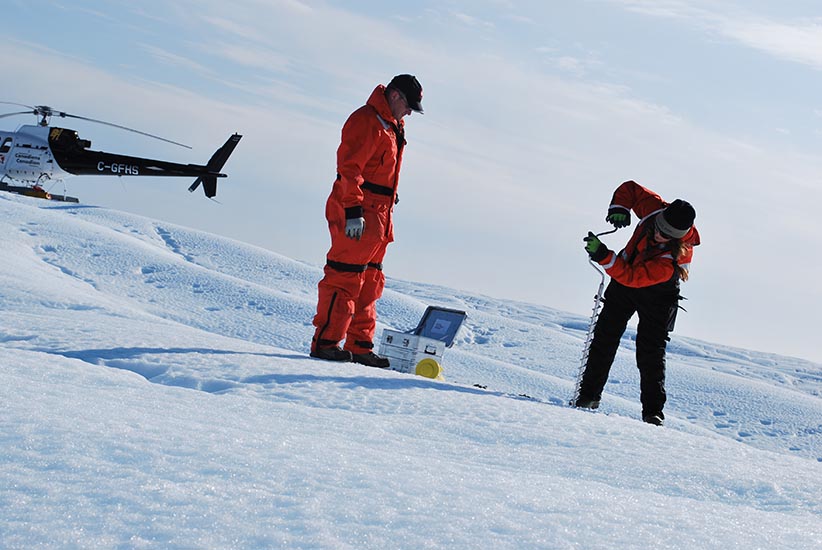Global warming makes ice forecasting a hot field
Ice forecasting — meteorology, oceanography, and a lot of thermodynamics — is a growing field, as climate change makes the Arctic more accessible
C-CORE Team setting Argos Beacons on PIIa. (Carl Howell/C-CORE)
Share

From flying planes over the Arctic’s vast surface to crunching numbers with cutting-edge technology, a small but growing group of young engineers are keeping ships safe from the hazards of ice while working at the forefront of computer science.
In Canada, ice forecasting dates back to the Cold War, when the government needed safe routes to install missile radar in the Far North. It has since grown with recent developments in computing capacity and weather modelling—not to mention interest in tourism, shipping, and oil and gas exploration in the Northwest Passage. With changing climate and an estimated 90 billion barrels of oil buried under the Arctic, ice forecasting promises hot salaries and rapid career advancement.
“It’s about meteorology, oceanography, and a lot of thermodynamics,” explains Martin Richard, a civil engineering professor at Memorial University in St. John’s, Nfld. “You learn so many useful things, and it’s lots of fun.”
At Memorial, both civil and naval engineering students at the graduate level can specialize in ice forecasting by undertaking research projects through C-CORE, an arms-length corporation funded by oil and gas companies. Meanwhile, two undergraduate courses offer some basic knowledge of ice issues that can lead to student research jobs.
Those who take on ice forecasting as a career use a mix of real-time data and historical patterns to predict ocean currents, the pace of ice growth and the best time for a client to move equipment and ice-breakers across the globe.
The technology could prevent the fate of the Franklin expedition (icebound) or the Titanic (iceberg collision) befalling the crew and passengers of a much more modern ship, such as the 1,070-passenger cruise liner Crystal Serenity, the largest vessel ever to navigate the Northwest Passage. It just completed its maiden voyage.
On rare occasions, engineers plant acoustic sensors on the Arctic seabed to calculate ice thickness, or fly in planes outfitted with devices to measure ice drifts. But ice forecasting isn’t solely for fans of cold climates; most of the work involves processing statistics from satellites, weather stations and historical databases.
“The love of coding is essential,” says Richard. “You’re translating all these variables into a real basis for assessing safety.”
At 36, Richard was cross-appointed last year as a professor for both C-CORE and Memorial’s civil engineering department. He says data-savvy Canadians with a passion for computing can thrive in his field, and that all six students he’s currently supervising have strong job prospects.
One of them, Joshua Barnes, says it’s a challenging, rewarding way to work with data. “It’s trying to make usable sense out of a very complex and sometimes chaotic environment,” says Barnes, who completed his bachelor degree at Memorial in ocean and naval architectural engineering. That degree normally leads to a career building ships, but Barnes learned from his professors that ice forecasting involves building computer software that can recognize statistical patterns.
“We’re able to capitalize on all the new techniques and technologies and apply it to a number of different fields,” says Barnes. “Any new entrants who have good ideas, who are motivated and genuinely interested, can go far.”
Yearly wages for government ice engineers and researchers start around $55,000, while companies prospecting for offshore oil pay higher rates, with six-figure salaries for mid-career staff.
In Ottawa, Environment Canada employs 15 people to do ice forecasting, while another 10 analysts interpret satellite data, such as identifying type of ice in satellite photos. Their findings help Coast Guard patrols, and are increasingly informing the work of meteorologists.
“Solid ice can act as land, and that changes weather patterns and the wind,” explains Darlene Langlois, chair of the Meteorological Service of Canada. In August, they had one ice forecaster aboard Canadian Coast Guard Ship Louis S. St-Laurent on a six-week expedition near the North Pole. Her colleagues often spend weeks at Coast Guard offices in St. John’s and Montreal.
In the private sector, Alberta-based sea-ice specialists Canatec employs 12 staff, based in Calgary, St. John’s and the Dutch city of The Hague. Meanwhile, Montreal-based cargo-shipping multinational Fednav runs an on-board ice-forecasting computer system, IceNav, which is maintained by a handful of analysts.